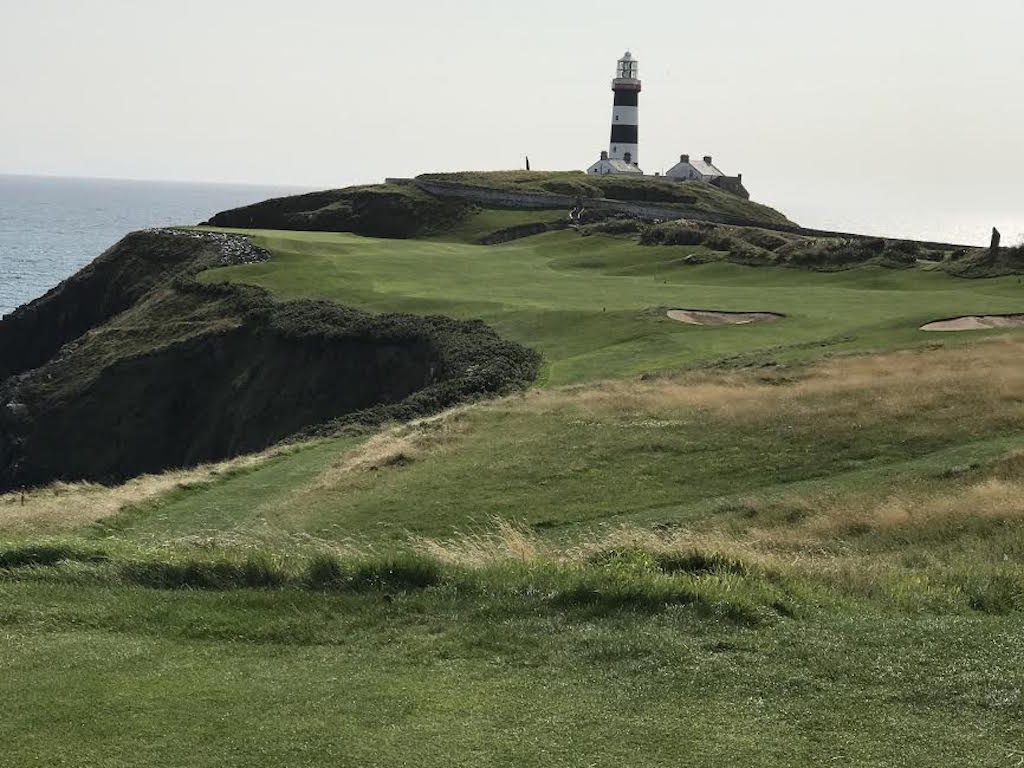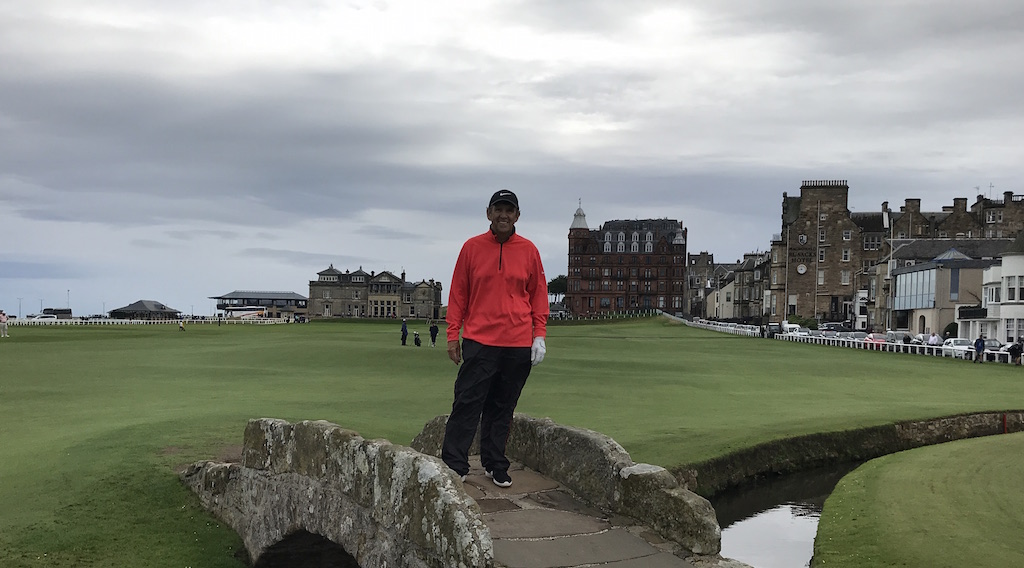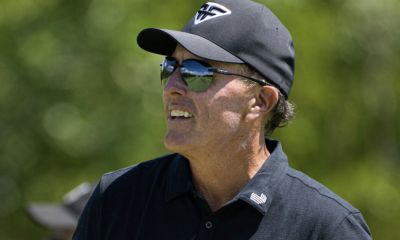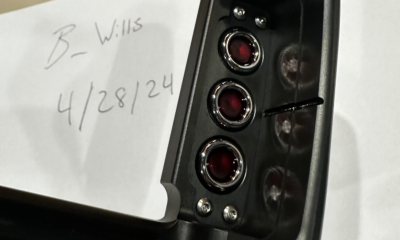Opinion & Analysis
Tips for playing true links golf courses in Ireland and Scotland

l just returned from two weeks in the UK where I played nine of the greatest links golf courses of the world. This was my third year in a row of exploring links golf, as the two years prior I went to Bandon Dunes and Cabot Links, which are probably the two places in North America that most closely resemble links turf.
The term “links” has been widely used in our country to mean several things, which it really is not, such as “I’m hittin’ the links tomorrow.” In other words, playing golf. But the term has a more precise definition: Links land is land that links the sea to the arable land further on shore. The area where the sea was, has receded and now leaves an expanse of turf which will only support the growth of some reddish brown fescue grasses. So if the color green is what you like on a golf course, stay home.
The growth is very low, the land is very rolling and hilly, firm, and the ground is simply whatever the sea has left on its retreat. While the golf courses on this land are pretty much whatever nature left there, a human being had to come and decide where tees, greens, bunkers etc., should be placed. It is even likely that many of the bunkers on the old courses might have been naturally dug by sheep and other animals seeking shelter from the harsh winds that blow in these area. Folklore? Fact? Who knows. But I do know this, the game that is played on this land is a whole other game than what many of us have come to know. The most we get in North America are “links style” or “links like” courses, usually meaning the absence of trees. These are not links courses. Here are some notable differences in how true links courses play.
First of all, because of the wind and the tight, firm turf, the golf ball flies lower. My advice is do not try to do anything about this, it’s simply a matter of the ballistics of impact. Think about shots you have played here in the U.S. from “hard pan” — they fly lower. You do not have the one inch or so grass under the golf ball as a launching pad, so accept lower flight…on ALL shots from the turf, not just around the green.
Now this works in your favor, because much of the time, we don’t want the golf ball to fly too high with the ever-present winds blowing. Most mistakes are made by players who try to hit high shots off very tight lies. Around the greens, putt whenever you can! When I did chip, I had some success with the ball slightly back, weight forward and hands ahead but… very little wrist set on most shots around the green, regardless of club selection. This keeps the hands in front, but avoids getting too steep into the firm turf. So if you closely observe elite-level players they are hitting de-lofted, low shots with a shallow somewhat shallow attack angle. I think anyone wishing to improve their iron game should learn to play links-land golf courses. There is far more putting and chipping with hybrids and 6-irons from off the green than in the U.S.
The second thing to be aware of is the line of play. It is critical in links golf. Take for example. a bunker guarding a green on one side. If you are forced to play over that bunker for your approach, you are faced with a very difficult shot, which invariably bounces over the green and into some heather or gorse behind the green making for an impossible up and in. My advice is play away from the bunker and short of the green for a much simpler short chip or putt. Here at home we can play over bunkers when forced to (it’s not optimal) because the softer greens mostly hold shots. Not in links golf! So try and check the hole location to know what side of the fairway to play in from. Yes, I know most of you are thinking, “I just wanna hit it solid,” but these observations could help, when you CAN control your tee ball. Try your level best to come into the green from the open, unprotected side.
Another word to the wise: avoid the heather (high rough fescue) and REALLY avoid the gorse bushes (unplayable lies to be sure). These grasses often cross the fairways so, when you play there, be sure to know how far they are from you; treat them like the hazards they are. You’ll need to lay well back of them if you can. I’d advise having 180 in from the fairway over 140 in the fescue. It is that different. Of course we can’t simply control tee shots, I’m referring more to the lay up shots. A bogey is NOT a bad score. Doubles and “others” come from the gorse, deep fairway bunkers and the heavy rough.
Which brings me to my next point, the roll of the golf ball. A shot on a links course is never good until it stops rolling! I hit a few drives 300 yards (I’m 70 years old). I hit what I thought were good draws right down the middle only to find them in the left fescue. If you do have a swing from the light rough (fescue) and the grass is growing toward the green, allow for “flyers” that might run 50 yards after landing. I hit an 8-iron that ended up near 200 yards once!
Avoid the fairway pot bunkers at all costs. If you get in one, take your sand wedge and play back to the fairway. I observed a number of players trying to play at the green. This is a HUGE mistake. Forget your distance to the hole, forget the green and get back on the fairway. It will save you a lot of strokes. Bobby Jones once remarked that the toughest shot in golf is the “pitch back to the fairway.”
In the greenside bunkers, there is less of a problem, but I might offer this advice: You are likely to find wetter, heavier sand than you might in the U.S. These shots require less bounce on the sand wedge or lob wedge, so one might consider that in your club selection. If you play your regular sand wedge, you may want to open it less at address and not “fan it” as much taking it back. This will minimize the bounce, let the leading edge work a little more than we might in fine, loose sand and help you explode better on to the green.
Another distinction…actual yardage means less than it does here at home. The wind, the elevation, the roll of the golf ball, all affect your club selection much more so than the actual yardage. The best advice here is get a good caddy who knows the actual distance, but will give you the real playing yardage.
The greens are large, quite undulating amd MUCH less defined. They also roll slower than out golf courses, because they are so exposed. A green speed over 10 is unlikely. The biggest difference we encounter is the effect of the wind on putts. If you get an experienced caddie, he/she is likely to remind you FIRST of the wind factor on the putts. For those of us who play in the states, wind is not the first thought we have on the putting surface. But it needs to be on the seaside fine fescue links greens. If those greens were at the speed of some creeping bent grasses, rounds might take in excess of six hours!

If you love of the game, and it is at all possible, go play golf in Scotland and or Ireland. There is something mystical about crossing the Swilcan Bridge, or playing out of the road hole bunker that no other place in golf offers. Walking the ancient fairways of Ballybunion or St. Andrews, where it is likely that every great player who has ever lived has played, (Augusta by comparison has been played by every great since 1934; Old Tom Morris was long gone by then) is a truly memorable experience.
These countries gave us our game game as we know it, and it is their national pasttime. I do not mean to discredit Cypress Point or Pine Valley, Merion or Oakmont one bit. They are wonderful fields of play (and much more difficult in my opinion) but they go back 100 years, not perhaps 500 years or more. The hallowed grounds that comprise the old links courses have been there since time began, and the idea of hitting a ball in a hole with a stick started there, and these things are palpable when you play there. But be prepared, it is a different game to be sure. And be sure to pack for every weather situation you can imagine. Even in the same day! I asked my caddie at the Old Course what the weather forecast was. He replied, “I can give you a 3-hole forecast at best.” And right he was. There were at least six weather changes that day. Anyway, I hope these tips help you if you ever get across the pond.
PS: Be prepared for five-plus hour rounds. Most of these courses are “bucket list” destinations and tourists take their time!
- LIKE47
- LEGIT7
- WOW1
- LOL1
- IDHT1
- FLOP0
- OB1
- SHANK5
19th Hole
Vincenzi’s LIV Golf Singapore betting preview: Course specialist ready to thrive once again

After another strong showing in Australia, LIV Golf will head to Sentosa Golf Club in Singapore looking to build off of what was undoubtedly their best event to date.
Sentosa Golf Club sits on the southern tip of Singapore and is one of the most beautiful courses in the world. The course is more than just incredible scenically; it was also rated 55th in Golf Digest’s top-100 courses in 2022-2023 and has been consistently regarded as one of the best courses in Asia. Prior to being part of the LIV rotation, the course hosted the Singapore Open every year since 2005.
Sentosa Golf Club is a par 71 measuring 7,406 yards. The course will require precise ball striking and some length off the tee. It’s possible to go low due to the pristine conditions, but there are also plenty of hazards and difficult spots on the course that can bring double bogey into play in a hurry. The Bermudagrass greens are perfectly manicured, and the course has spent millions on the sub-air system to keep the greens rolling fast. I spoke to Asian Tour player, Travis Smyth, who described the greens as “the best [he’s] ever played.”
Davis Love III, who competed in a Singapore Open in 2019, also gushed over the condition of the golf course.
“I love the greens. They are fabulous,” the 21-time PGA Tour winner said.
Love III also spoke about other aspects of the golf course.
“The greens are great; the fairways are perfect. It is a wonderful course, and it’s tricky off the tee.”
“It’s a long golf course, and you get some long iron shots. It takes somebody hitting it great to hit every green even though they are big.”
As Love III said, the course can be difficult off the tee due to the length of the course and the trouble looming around every corner. It will take a terrific ball striking week to win at Sentosa Golf Club.
In his pre-tournament press conference last season, Phil Mickelson echoed many of the same sentiments.
“To play Sentosa effectively, you’re going to have a lot of shots from 160 to 210, a lot of full 6-, 7-, 8-iron shots, and you need to hit those really well and you need to drive the ball well.”
Golfers who excel from tee to green and can dial in their longer irons will have a massive advantage this week.
Stat Leaders at LIV Golf Adelaide:
Fairways Hit
1.) Louis Oosthuizen
2.) Anirban Lahiri
3.) Jon Rahm
4.) Brendan Steele
5.) Cameron Tringale
Greens in Regulation
1.) Brooks Koepka
2.) Brendan Steele
3.) Dean Burmester
4.) Cameron Tringale
5.) Anirban Lahiri
Birdies Made
1.) Brendan Steele
2.) Dean Burmester
3.) Thomas Pieters
4.) Patrick Reed
5.) Carlos Ortiz
LIV Golf Individual Standings:
1.) Joaquin Niemann
2.) Jon Rahm
3.) Dean Burmester
4.) Louis Oosthuizen
5.) Abraham Ancer
LIV Golf Team Standings:
1.) Crushers
2.) Legion XIII
3.) Torque
4.) Stinger GC
5.) Ripper GC
LIV Golf Singapore Picks
Sergio Garcia +3000 (DraftKings)
Sergio Garcia is no stranger to Sentosa Golf Club. The Spaniard won the Singapore Open in 2018 by five strokes and lost in a playoff at LIV Singapore last year to scorching hot Talor Gooch. Looking at the course setup, it’s no surprise that a player like Sergio has played incredible golf here. He’s long off the tee and is one of the better long iron players in the world when he’s in form. Garcia is also statistically a much better putter on Bermudagrass than he is on other putting surfaces. He’s putt extremely well on Sentosa’s incredibly pure green complexes.
This season, Garcia has two runner-up finishes, both of them being playoff losses. Both El Camaleon and Doral are courses he’s had success at in his career. The Spaniard is a player who plays well at his tracks, and Sentosa is one of them. I believe Sergio will get himself in the mix this week. Hopefully the third time is a charm in Singapore.
Paul Casey +3300 (FanDuel)
Paul Casey is in the midst of one of his best seasons in the five years or so. The results recently have been up and down, but he’s shown that when he’s on a golf course that suits his game, he’s amongst the contenders.
This season, Casey has finishes of T5 (LIV Las Vegas), T2 (LIV Hong Kong), and a 6th at the Singapore Classic on the DP World Tour. At his best, the Englishman is one of the best long iron players in the world, which makes him a strong fit for Sentosa. Despite being in poor form last season, he was able to fire a Sunday 63, which shows he can low here at the course.
It’s been three years since Casey has won a tournament (Omega Dubai Desert Classic in 2021), but he’s been one of the top players on LIV this season and I think he can get it done at some point this season.
Mito Pereira +5000 (Bet365)
Since Mito Pereira’s unfortunate demise at the 2022 PGA Championship, he’s been extremely inconsistent. However, over the past few months, the Chilean has played well on the International Series as well as his most recent LIV start. Mito finished 8th at LIV Adelaide, which was his best LIV finish this season.
Last year, Pereira finished 5th at LIV Singapore, shooting fantastic rounds of 67-66-66. It makes sense why Mito would like Sentosa, as preeminent ball strikers tend to rise to the challenge of the golf course. He’s a great long iron player who is long and straight off the tee.
Mito has some experience playing in Asia and is one of the most talented players on LIV who’s yet to get in the winner’s circle. I have questions about whether or not he can come through once in contention, but if he gets there, I’m happy to roll the dice.
Andy Ogletree +15000 (DraftKings)
Andy Ogletree is a player I expected to have a strong 2024 but struggled early in his first full season on LIV. After failing to crack the top-25 in any LIV event this year, the former U.S. Amateur champion finally figured things out, finished in a tie for 3rd at LIV Adelaide.
Ogletree should be incredible comfortable playing in Singapore. He won the International Series Qatar last year and finished T3 at the International Series Singapore. The 26-year-old was arguably the best player on the Asian Tour in 2023 and has been fantastic in the continent over the past 18 months.
If Ogletree has indeed found form, he looks to be an amazing value at triple-digit odds.
- LIKE3
- LEGIT3
- WOW1
- LOL2
- IDHT0
- FLOP2
- OB0
- SHANK0
Opinion & Analysis
Ryan: Lessons from the worst golf instructor in America

In Tampa, there is a golf course that boasts carts that do not work, a water range, and a group of players none of which have any chance to break 80. The course is overseen by a staff of crusty men who have succeeded at nothing in life but ending up at the worst-run course in America. However, this place is no failure. With several other local courses going out of business — and boasting outstanding greens — the place is booked full.
While I came for the great greens, I stayed to watch our resident instructor; a poor-tempered, method teacher who caters to the hopeless. At first, it was simply hilarious. However, after months of listening and watching, something clicked. I realized I had a front-row seat to the worst golf instructor in America.
Here are some of my key takeaways.
Method Teacher
It is widely accepted that there are three types of golf instructors: system teachers, non-system teachers, and method teachers. Method teachers prescribe the same antidote for each student based on a preamble which teachers can learn in a couple day certification.
Method teaching allows anyone to be certified. This process caters to the lowest caliber instructor, creating the illusion of competency. This empowers these underqualified instructors with the moniker of “certified” to prey on the innocent and uninformed.
The Cult of Stack and Jilt
The Stack and Tilt website proudly boasts, “A golfer swings his hands inward in the backswing as opposed to straight back to 1) create power, similar to a field goal kicker moving his leg in an arc and 2) to promote a swing that is in-to-out, which produces a draw (and eliminates a slice).”
Now, let me tell you something, there is this law of the universe which says “energy can either be created or destroyed,” so either these guys are defying physics or they have no idea what they are taking about. Further, the idea that the first move of the backswing determines impact is conjecture with a splash of utter fantasy.
These are the pontifications of a method — a set of prescriptions applied to everyone with the hope of some success through the placebo effect. It is one thing for a naive student to believe, for a golf instructor to drink and then dispel this Kool-Aid is malpractice.
Fooled by Randomness
In flipping a coin, or even a March Madness bet, there is a 50-50 chance of success. In golf, especially for new players, results are asymmetric. Simply put: Anything can happen. The problem is that when bad instructors work with high handicappers, each and every shot gets its own diagnosis and prescription. Soon the student is overwhelmed.
Now here’s the sinister thing: The overwhelming information is by design. In this case, the coach is not trying to make you better, they are trying to make you reliant on them for information. A quasi Stockholm syndrome of codependency.
Practice
One of the most important scientists of the 20th century was Ivan Pavlov. As you might recall, he found that animals, including humans, could be conditioned into biological responses. In golf, the idea of practice has made millions of hackers salivate that they are one lesson or practice session from “the secret.”
Sunk Cost
The idea for the worst golf instructor is to create control and dependency so that clients ignore the sunk cost of not getting better. Instead, they are held hostage by the idea that they are one lesson or tip away from unlocking their potential.
Cliches
Cliches have the effect of terminating thoughts. However, they are the weapon of choice for this instructor. Add some hyperbole and students actually get no information. As a result, these players couldn’t play golf. When they did, they had no real scheme. With no idea what they are doing, they would descend into a spiral of no idea what to do, bad results, lower confidence, and running back to the lesson tee from more cliches.
The fact is that poor instruction is about conditioning players to become reliant members of your cult. To take away autonomy. To use practice as a form of control. To sell more golf lessons not by making people better but through the guise that without the teacher, the student can never reach their full potential. All under the umbrella of being “certified” (in a 2-day course!) and a melee of cliches.
This of course is not just happening at my muni but is a systemic problem around the country and around the world, the consequences of which are giving people a great reason to stop playing golf. But hey, at least it’s selling a lot of golf balls…
- LIKE18
- LEGIT2
- WOW0
- LOL4
- IDHT1
- FLOP4
- OB1
- SHANK24
19th Hole
Vincenzi’s 2024 Zurich Classic of New Orleans betting preview

The PGA TOUR heads to New Orleans to play the 2023 Zurich Classic of New Orleans. In a welcome change from the usual stroke play, the Zurich Classic is a team event. On Thursday and Saturday, the teams play best ball, and on Friday and Sunday the teams play alternate shot.
TPC Louisiana is a par 72 that measures 7,425 yards. The course features some short par 4s and plenty of water and bunkers, which makes for a lot of exciting risk/reward scenarios for competitors. Pete Dye designed the course in 2004 specifically for the Zurich Classic, although the event didn’t make its debut until 2007 because of Hurricane Katrina.
Coming off of the Masters and a signature event in consecutive weeks, the field this week is a step down, and understandably so. Many of the world’s top players will be using this time to rest after a busy stretch.
However, there are some interesting teams this season with some stars making surprise appearances in the team event. Some notable teams include Patrick Cantlay and Xander Schauffele, Rory McIlroy and Shane Lowry, Collin Morikawa and Kurt Kitayama, Will Zalatoris and Sahith Theegala as well as a few Canadian teams, Nick Taylor and Adam Hadwin and Taylor Pendrith and Corey Conners.
Past Winners at TPC Louisiana
- 2023: Riley/Hardy (-30)
- 2022: Cantlay/Schauffele (-29)
- 2021: Leishman/Smith (-20)
- 2019: Palmer/Rahm (-26)
- 2018: Horschel/Piercy (-22)
- 2017: Blixt/Smith (-27)
2024 Zurich Classic of New Orleans Picks
Tom Hoge/Maverick McNealy +2500 (DraftKings)
Tom Hoge is coming off of a solid T18 finish at the RBC Heritage and finished T13 at last year’s Zurich Classic alongside Harris English.
This season, Hoge is having one of his best years on Tour in terms of Strokes Gained: Approach. In his last 24 rounds, the only player to top him on the category is Scottie Scheffler. Hoge has been solid on Pete Dye designs, ranking 28th in the field over his past 36 rounds.
McNealy is also having a solid season. He’s finished T6 at the Waste Management Phoenix Open and T9 at the PLAYERS Championship. He recently started working with world renowned swing coach, Butch Harmon, and its seemingly paid dividends in 2024.
Keith Mitchell/Joel Dahmen +4000 (DraftKings)
Keith Mitchell is having a fantastic season, finishing in the top-20 of five of his past seven starts on Tour. Most recently, Mitchell finished T14 at the Valero Texas Open and gained a whopping 6.0 strokes off the tee. He finished 6th at last year’s Zurich Classic.
Joel Dahmen is having a resurgent year and has been dialed in with his irons. He also has a T11 finish at the PLAYERS Championship at TPC Sawgrass which is another Pete Dye track. With Mitchell’s length and Dahmen’s ability to put it close with his short irons, the Mitchell/Dahmen combination will be dangerous this week.
Taylor Moore/Matt NeSmith +6500 (DraftKings)
Taylor Moore has quickly developed into one of the more consistent players on Tour. He’s finished in the top-20 in three of his past four starts, including a very impressive showing at The Masters, finishing T20. He’s also finished T4 at this event in consecutive seasons alongside Matt NeSmith.
NeSmith isn’t having a great 2024, but has seemed to elevate his game in this format. He finished T26 at Pete Dye’s TPC Sawgrass, which gives the 30-year-old something to build off of. NeSmith is also a great putter on Bermudagrass, which could help elevate Moore’s ball striking prowess.
- LIKE8
- LEGIT3
- WOW1
- LOL1
- IDHT0
- FLOP3
- OB1
- SHANK2
-

 19th Hole2 weeks ago
19th Hole2 weeks agoJustin Thomas on the equipment choice of Scottie Scheffler that he thinks is ‘weird’
-

 19th Hole2 weeks ago
19th Hole2 weeks ago‘Absolutely crazy’ – Major champ lays into Patrick Cantlay over his decision on final hole of RBC Heritage
-

 19th Hole3 weeks ago
19th Hole3 weeks agoReport: LIV Golf identifies latest star name they hope to sign to breakaway tour
-

 19th Hole3 weeks ago
19th Hole3 weeks agoBrandel Chamblee has ‘no doubt’ who started the McIlroy/LIV rumor and why
-

 19th Hole1 week ago
19th Hole1 week agoLET pro gives detailed financial breakdown of first week on tour…and the net result may shock you
-

 Equipment3 weeks ago
Equipment3 weeks agoJason Day on his recent switch into Srixon ZX5 and ZX7 Mk II irons
-

 19th Hole5 days ago
19th Hole5 days agoGary Player claims this is what ‘completely ruined’ Tiger Woods’ career
-

 Whats in the Bag1 week ago
Whats in the Bag1 week agoTeam McIlowry (Rory McIlroy, Shane Lowry) winning WITBs: 2024 Zurich Classic



























Bob P
Dec 19, 2018 at 10:40 am
Dennis,
What were the 9 courses you played
RFP
Dec 19, 2018 at 9:27 am
Dennis, which 9 course did you play?
Debtor
Sep 9, 2018 at 10:19 pm
Lost all credibility with the photo of Old Head to lead the story off…
Tartan Golf Travel
Sep 9, 2018 at 10:56 am
I own a Golf Travel company and we specialize in trips to Scotland and Ireland. A couple of tips. 1. Forget your umbrella and just have great waterproofs. 2. Find some hidden gems which will offset the costs of playing some of the high $ must play courses. 3. Take caddie. A lot of tee shots are blind.
I just sent a group over last week. 7 days all in St. Andrews. (Kingsbarns, Old Course, New , Jubilee, Castle, Carnoustie, North Berwick. £2000
SV
Sep 9, 2018 at 10:27 am
First, I have only once encountered a round close to five hours, even playing Carnousie, St. Andrews Old and others. Second, lower your score expectations. A low handicap golfer will generally shoot from 5-10 strokes above their normal score. Higher handicaps will generally be even more above their norm.
As opposed to the US you can easily play private clubs, although some require proof of handicap. Most of all it is a great experience.
T
Sep 9, 2018 at 8:39 am
Ireland is not the UK.
And why do you Yanks always have to add extra bits like “true” before the actual subject and embellish it? It’s a links course. That’s it. That’s all it is. No need for true. So much hyperbolic language in the US and you fool each other thinking there are fake things in the world to trick you or something. Weird culture you got.
Dennis clark
Sep 9, 2018 at 11:01 am
True that. I mistakenly referred to Ireland in UK which in fact iinckudes Northern Ireland. True is an adjective to distinguish Links from faux links and to identify the turf on which it lies. That is hardly an embellishment or hyperbole. Regarding to the culture here as “weird” seems uniquely hyperbolic however.
Johnny Penso
Sep 9, 2018 at 8:03 pm
I believe his point is that the adjective is not necessary. A course is either a links or it is not. So one only need say, “these are the features of a links type of golf course” and if you want to juxtapose that with what we North Americans would commonly call a “links style” course you would simply say it isn’t a links course because it doesn’t have the aforementioned features of a links course. Or you could say it’s no more a links course than a copy of the Mona Lisa is a “Mona Lisa style” painting. I live in Canada and it is weird to me. I especially love the double adjective.
“How was the course today”
“It wasn’t hard hard but it was still pretty hard”
Drives me a little batty when I hear people talking like that and it happens all the time…lol.
Lo T
Sep 9, 2018 at 10:27 pm
Eh? lol
James
Sep 8, 2018 at 5:47 pm
… and always remember to bring along a flask of a good single-malt scotch.
Dennis clark
Sep 8, 2018 at 4:26 pm
I didn’t go there. Or I would have written about them.
Luke
Sep 8, 2018 at 1:17 pm
Why exclude England and Wales. There are plenty of great links course in those countries.